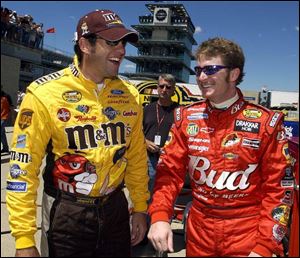
Indy awes NASCAR drivers
8/8/2004
Elliott Sadler, left, who qualified third for the Brickyard 400, and Dale Earnhardt Jr., who qualified fifth, share a joke Friday. Sadler says track position is very important at Indianapolis.
INDIANAPOLIS - Listen to the NASCAR drivers talk about racing at the Indianapolis Motor Speedway, and the tone is always reverent, respectful.
It is a lot like golfers talking about Augusta National, or a fly fisherman praising the Yellowstone River. They will certainly do better at other locales, but no place can match the mystique.
When the 11th running of the Brickyard 400 takes place here this afternoon, none of the principal combatants expects a classic race to develop. The Brickyard has become the No. 2 event on the Nextel Cup Series schedule based on the place, not the product.
"It is a lot like that, because the Brickyard has definitely become a 'major' in the Nextel Cup Series," veteran driver Ken Schrader said. "That Sunday walk onto the starting grid at Indy is kind of like what golfers say a Sunday's walk out to the first tee at Augusta is, or going on the field for the first game of the World Series."
The Indianapolis Motor Speedway was not built for stock car racing. For close to 100 years, it has played host to the most famous race in the world, the Indy 500, for a field of open-wheeled cars. It wasn't until 1994 that the Speedway showcased the boys from NASCAR, but to a man, the stock car drivers cite a love and an adoration for the place.
Then they talk about how tough it is to race here.
Built originally as a test facility for the growing car industry in Indiana, the track was paved with 3.2 million bricks in 1909. Those were paved over with asphalt long ago, and only a narrow strip of bricks remains visible at the start/finish line. But the revered Brickyard is narrow and flat with less banking, and not suited for the passing and four-wide-racing that give Cup races excitement.
"There are no specific places to pass here," said Ryan Newman, who qualified seventh yesterday at 184.332 mph yesterday. "Some racetracks are more conducive for passing coming off turns, and some are more conducive for passes going into turns. But here, you're at the mercy of the guys in front of you and clean air."
Besides being wider in both the straightaways and turns, a track like Michigan International Speedway offers drivers three or four usable grooves, while the Speedway has but one or two. That creates far fewer opportunities for challenges and passes for the stock cars, which are just over six-feet wide.
"It's a one groove track until the end of the race," Newman said. "It can be a two groove track at the end of the race, but the ideal groove is typically at the bottom. And the best place to pass is in the pits."
Elliott Sadler, who qualified third, said drivers go into a race at a wider track like MIS with not as many concerns if they have to start near the back, since they can often make up the ground over the course of the race. But that is a much more difficult task at the Speedway, where qualifying becomes more critical.
"Track position is so very important here, and everybody knows that," Sadler said. "It is the number one thing here. You don't have to take the chances on pit strategy and all if you are in the front."
When the subject of bringing stock cars to the Speedway was first raised years ago, many of the racing traditionalists and purists were vehemently opposed. This had been a one-race track for so long, and there was considerable resistance to changing that. Some simply did not want the moonshine runners soiling sacred ground.
The Brickyard 400 has been a major success since its inception in 1994, attracting huge crowds, strong television numbers, and generating an enormous second income for the Speedway. Some say track owner Tony George saw the Brickyard as a means to finance his Indy Racing League, which he started the same year. Most Nextel Cup drivers are just happy to be here.
"Indianapolis wasn't built for the purpose of the Nextel Cup Series, just like Daytona wasn't built for Indy cars," driver Jeff Green said. "But each time we come to Indy, it's like the atmosphere of a Daytona. The Brickyard 400 is a race that solidifies NASCAR as America's most popular sport. Having our series race on this famed oval and sell out the track each season just proves how large of a sport we have become."
Once they get here, however, the stock car drivers face the reality of racing at Indy. If you are not out front, you need a lot of luck and more than a few breaks to be part of the lead pack.
"This track and Pocono are the two places where racing in clean air is the most critical," pole-sitter Casey Mears said. "If you can get out in front and run in clean air, that can make a big difference in time."
Brian Vickers, the top qualifier among the five rookies in the field at sixth, said he intends to stay out front and not put himself in position where he has to pass a number of cars on this layout.
"Come Sunday, you want to get to the front as quick as you can and stay there," Vickers said. "Track position is something we talk about all of the time, and it is important every week because it is always safer up front. But at this track it is extremely important because there are just not many opportunities to get around people."
Contact Matt Markey at: mmarkey@theblade.com or 419-724-6510.